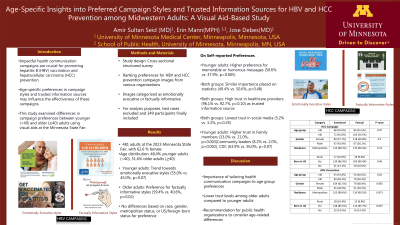Tuesday Poster Session
Category: Liver
P4587 - Age-Specific Insights into Preferred Campaign Styles and Trusted Information Sources for HBV and HCC Prevention among Midwestern Adults: A Visual Aid-Based Study
Tuesday, October 29, 2024
10:30 AM - 4:00 PM ET
Location: Exhibit Hall E

Has Audio

Amir Sultan Seid, MD
University of Minnesota
Minneapolis, MN
Presenting Author(s)
Amir Sultan Seid, MD1, Erin Mann, MPH2, Jose Debes, MD, PhD1
1University of Minnesota, Minneapolis, MN; 2University of Minnesota School of Public Health, Minneapolis, MN
Introduction: Impactful health communication campaigns are crucial for promoting hepatitis B (HBV) vaccination and hepatocellular carcinoma (HCC) prevention. This study aimed to examine the differences in campaign preference styles and trusted sources of information between younger (age < 40) and older (age ≥40) adults attending the Minnesota State Fair by utilizing visual aids.
Methods: A cross-sectional structured survey was conducted among 481 adults attending the 2023 Minnesota State Fair. Participants were shown images of different HBV and HCC prevention campaigns from various organizations and asked to rank their preferences. Images were categorized as emotionally evocative or factually informative for analysis purposes. Tied cases were excluded, and differences among groups based on age were analyzed Chi-square test . Respondents were also asked about trusted sources of health information.
Results: In the survey population, 48.4% of respondents were younger adults (age < 40), and 51.6% were older adults (age ≥40). Females comprised 62.6% of the sample. When shown campaign images for HCC prevention, younger adults showed a trend towards preferring emotionally evocative campaign styles compared to older adults (55.0% vs. 45.0%, p=0.07). For HBV campaigns, older adults were more likely to prefer factually informative styles (59.4% vs. 40.6%, p=0.02). No differences in campaign preference were observed based on race, gender, metropolitan status, or being US/foreign-born. In self-reported preferences, younger adults reported that memorable or humorous messages were more important than older adults (50.6% vs. 37.9%, p=0.005). Both groups reported similar rates of importance for seeing statistics (49.4% vs. 50.6%, p=0.48). Regarding trusted sources of information, both younger and older adults highly trusted their healthcare providers (96.1% vs. 92.7%, p=0.10). However, younger adults were more likely to trust family members (33.0% vs. 21.0%, p=0.003), community leaders (8.2% vs. 2.0%, p=0.002), and the Centers for Disease Control (CDC) (63.9% vs. 56.0%, p=0.07) compared to older adults. Social media was the least trusted source for both (5.2% vs. 3.2%, p=0.29).
Discussion: The findings of this study highlight the importance of tailoring health communication campaigns to the preferences and trusted sources of different age groups. Trust levels were notably lower among older adults compared to younger adults. Public health organizations should consider these age-related differences.
Disclosures:
Amir Sultan Seid, MD1, Erin Mann, MPH2, Jose Debes, MD, PhD1. P4587 - Age-Specific Insights into Preferred Campaign Styles and Trusted Information Sources for HBV and HCC Prevention among Midwestern Adults: A Visual Aid-Based Study, ACG 2024 Annual Scientific Meeting Abstracts. Philadelphia, PA: American College of Gastroenterology.
1University of Minnesota, Minneapolis, MN; 2University of Minnesota School of Public Health, Minneapolis, MN
Introduction: Impactful health communication campaigns are crucial for promoting hepatitis B (HBV) vaccination and hepatocellular carcinoma (HCC) prevention. This study aimed to examine the differences in campaign preference styles and trusted sources of information between younger (age < 40) and older (age ≥40) adults attending the Minnesota State Fair by utilizing visual aids.
Methods: A cross-sectional structured survey was conducted among 481 adults attending the 2023 Minnesota State Fair. Participants were shown images of different HBV and HCC prevention campaigns from various organizations and asked to rank their preferences. Images were categorized as emotionally evocative or factually informative for analysis purposes. Tied cases were excluded, and differences among groups based on age were analyzed Chi-square test . Respondents were also asked about trusted sources of health information.
Results: In the survey population, 48.4% of respondents were younger adults (age < 40), and 51.6% were older adults (age ≥40). Females comprised 62.6% of the sample. When shown campaign images for HCC prevention, younger adults showed a trend towards preferring emotionally evocative campaign styles compared to older adults (55.0% vs. 45.0%, p=0.07). For HBV campaigns, older adults were more likely to prefer factually informative styles (59.4% vs. 40.6%, p=0.02). No differences in campaign preference were observed based on race, gender, metropolitan status, or being US/foreign-born. In self-reported preferences, younger adults reported that memorable or humorous messages were more important than older adults (50.6% vs. 37.9%, p=0.005). Both groups reported similar rates of importance for seeing statistics (49.4% vs. 50.6%, p=0.48). Regarding trusted sources of information, both younger and older adults highly trusted their healthcare providers (96.1% vs. 92.7%, p=0.10). However, younger adults were more likely to trust family members (33.0% vs. 21.0%, p=0.003), community leaders (8.2% vs. 2.0%, p=0.002), and the Centers for Disease Control (CDC) (63.9% vs. 56.0%, p=0.07) compared to older adults. Social media was the least trusted source for both (5.2% vs. 3.2%, p=0.29).
Discussion: The findings of this study highlight the importance of tailoring health communication campaigns to the preferences and trusted sources of different age groups. Trust levels were notably lower among older adults compared to younger adults. Public health organizations should consider these age-related differences.
Disclosures:
Amir Sultan Seid indicated no relevant financial relationships.
Erin Mann indicated no relevant financial relationships.
Jose Debes indicated no relevant financial relationships.
Amir Sultan Seid, MD1, Erin Mann, MPH2, Jose Debes, MD, PhD1. P4587 - Age-Specific Insights into Preferred Campaign Styles and Trusted Information Sources for HBV and HCC Prevention among Midwestern Adults: A Visual Aid-Based Study, ACG 2024 Annual Scientific Meeting Abstracts. Philadelphia, PA: American College of Gastroenterology.
